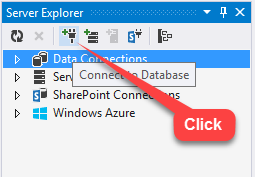This article provides an explanation about how to populate a dropdown list from the database using stored procedure in Asp.Net MVC with an example and also show you how you can get selected value from the dropdown list and use of @Html.Dropdownlist or @Html.DropdownlistFor properties to bind dropdown list based on the values from the database.
In my previous article, I explained Bootstrap JQuery Multiselect Dropdown List With Checkbox in ASP.NET Using C# And VB.NET and CRUD Operation Using Angular and WEB API 2 With Stored Procedure in Asp.Net MVC and AngularJS File Upload in ASP.NET using C# and VB.NET and Export JSON Data to Excel/CSV File using AngularJs With Bootstrap and also shared many other interesting articles on related technology that you might like to read.
Requirement
Implementation
So, Let's start with an example for demonstration purposes, but before that, we will create a database and then create a table and insert some dummy entries and write a stored procedure to get employee data for the bind drop-down list.
Step 1: Create a Database in SQL Server.
Step 2: Create a table with the name "Employee_Master".
CREATE TABLE [dbo].[Employee_Master] ( [EmpId] INT IDENTITY (1, 1) NOT NULL, [FirstName] NVARCHAR (50) NULL, [Department] NVARCHAR (25) NULL, [Designation] NVARCHAR (50) NULL, [CompanyName] NVARCHAR (100) NULL, CONSTRAINT [PK_Employee_Master] PRIMARY KEY CLUSTERED ([EmpId] ASC) );Step 3: Insert some dummy records in the table.
INSERT INTO Employee_Master VALUES ('Nikunj Satasiya','Computer/IT','Sr.Software Engineer','D&K Technologies'), ('Hiren Dobariya','Computer/IT','Sr.Software Engineer','Version System Pvt Ltd'), ('Sruti Patel','Network and Sequrity','Sr.Software Engineer','D&K Technologies'), ('Vivek Ghadiya','Computer/IT','Sr.Software Engineer','D&K Technologies'), ('Nikunj Ladani','Computer/IT','Sr.Software Engineer','Version System Pvt Ltd')Step 4: Write a Stored Procedure.
CREATE PROCEDURE Get_Employee AS BEGIN SELECT EmpId, FirstName,Department, Designation, CompanyName FROM Employee_Master WITH(NOLOCK) END
Note: The name of the controller must end with controller i.g EmployeeController, StudentController, ProductController and etc.
EmployeeModel.cs
using System;
using System.Collections.Generic; using System.ComponentModel.DataAnnotations; using System.Linq; using System.Web; namespace Codingvila.Models { public class EmployeeModel { public List<EmployeeModel> EmployeeInformation { get; set; } public int EmpId { get; set; } public string FirstName { get; set; } public string Department { get; set; } public string Designation { get; set; } public string CompanyName { get; set; } } }
EmployeeDBHandle.cs
using System; using System.Collections.Generic; using System.Configuration; using System.Data; using System.Data.SqlClient; using System.Linq; using System.Web; namespace Codingvila.Models { public class EmployeeDBHandle { private SqlConnection con; private void connection() { string constring = ConfigurationManager.ConnectionStrings["Conn"].ToString(); con = new SqlConnection(constring); } // ********** VIEW EMPLOYEE DETAILS ******************** public List<EmployeeModel> GetEmployee() { connection(); List<EmployeeModel> EmployeeInformation = new List<EmployeeModel>(); SqlCommand cmd = new SqlCommand("EXEC Get_Employee", con); cmd.CommandType = CommandType.StoredProcedure; SqlDataAdapter sd = new SqlDataAdapter(cmd); DataTable dt = new DataTable(); con.Open(); sd.Fill(dt); con.Close(); foreach (DataRow dr in dt.Rows) { EmployeeInformation.Add( new EmployeeModel { EmpId = Convert.ToInt32(dr["EmpId"]), FirstName = Convert.ToString(dr["FirstName"]), Department = Convert.ToString(dr["Department"]), Designation = Convert.ToString(dr["Designation"]), CompanyName = Convert.ToString(dr["CompanyName"]) }); } return EmployeeInformation; } } }
Web.Config
<connectionStrings> <add name="Conn" connectionString="Data Source=DESKTOP-P1PHIU6\SQLEXPRESS;Initial Catalog=DB_Codingvila;Integrated Security=True"/> </connectionStrings>
EmployeeController
using Codingvila.Models; using System; using System.Collections.Generic; using System.Linq; using System.Web; using System.Web.Mvc; namespace Codingvila.Controllers { public class EmployeeController : Controller { // // GET: /Employee/ public ActionResult Index() { EmployeeDBHandle dbhandle = new EmployeeDBHandle(); ModelState.Clear(); return View(dbhandle.GetEmployee()); } } }
Index.cshtml
@model Codingvila.Models.EmployeeModel @{ Layout = null; } <!DOCTYPE html> <html> <head> <meta name="viewport" content="width=device-width" /> <title>Employee Details</title> </head> <body> <div> <h1>Employee Detail</h1> <br> Employee Name :@Html.DropDownListFor(m => m.EmpId, new SelectList(Model.EmployeeInformation, "EmpId", "FirstName"), "") </div> </body> </html>
Note: your URL pattern must be something like ( http://yourdomain.com/ name of controller/name of action method ) i.g http://codingvila.com/articles/Index/, where articles are the name of my controller and Index, is my action method.


















